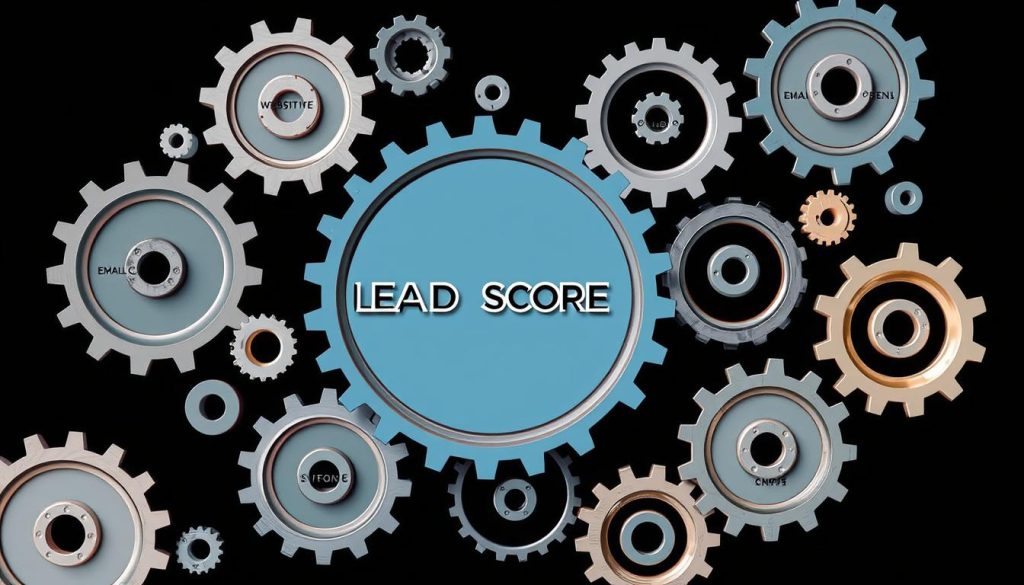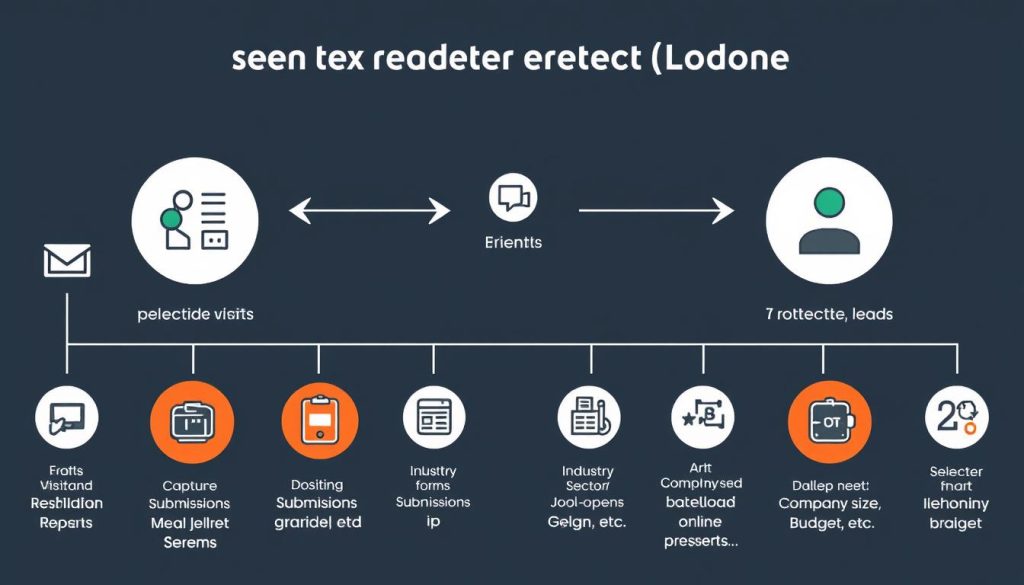Effective lead management is crucial for businesses seeking to maximize their sales and marketing efforts. In this article, we’ll explore the process of setting up lead scoring, a powerful strategy to prioritize and qualify leads from online capture. By understanding the key components of lead scoring, you’ll learn how to identify scoring criteria, assign point values, and integrate the system with your customer relationship management (CRM) platform.
Lead scoring is a methodical approach to evaluating the quality and sales-readiness of your leads. By assigning point values to specific characteristics and behaviors, you can effectively distinguish between high-value prospects and those that may require additional nurturing. This strategic approach empowers your sales and marketing teams to focus their efforts on the leads most likely to convert, ultimately boosting conversions and streamlining your sales process.
Key Takeaways
- Lead scoring is a strategic method to prioritize and qualify leads based on defined criteria.
- Identifying scoring criteria, such as demographic information and behavioral data, is crucial for effective lead scoring.
- Assigning point values to specific lead attributes enables you to differentiate between sales-ready prospects and those requiring further nurturing.
- Integrating lead scoring with your CRM system streamlines the lead management process and ensures seamless collaboration between sales and marketing teams.
- Continuous monitoring and refinement of lead scoring criteria is essential to maintain the system’s accuracy and effectiveness over time.
What is Lead Scoring?
Lead scoring is a powerful methodology that assigns numerical values to leads based on their perceived value and likelihood to convert. This strategic approach allows sales and marketing teams to prioritize and focus on the most promising prospects, streamlining the lead qualification process and driving more effective engagement.
Defining Lead Scoring
Lead scoring is a systematic way of evaluating and ranking leads according to their sales-readiness. By analyzing demographic information and behavior data, businesses can create a scoring model that identifies the most qualified leads, enabling them to allocate resources effectively and improve overall lead conversion rates.
Benefits of Lead Scoring
Implementing lead scoring offers numerous advantages for businesses, including:
- Improved Lead Quality: By focusing on the most valuable leads, sales and marketing teams can enhance the overall quality of the lead pipeline, leading to higher conversion rates and better return on investment.
- Enhanced Sales and Marketing Alignment: Lead scoring facilitates seamless collaboration between sales and marketing, as both teams can align on the criteria for qualified leads and work together to nurture and convert them.
- Increased Efficiency: By prioritizing the most promising leads, businesses can allocate resources more effectively, streamlining the sales process and improving overall productivity.
- Higher Conversion Rates: With lead qualification and lead prioritization at the core of lead scoring, businesses can expect to see a significant increase in conversion rates as they engage with the most sales-ready prospects.
By leveraging the power of lead scoring, businesses can transform their lead management strategies, driving better results and achieving greater success in their sales and marketing efforts.

Preparing for Lead Scoring Implementation
Before implementing a lead scoring system, it’s crucial to lay the groundwork. This includes evaluating your current lead management processes, identifying data sources, and ensuring your marketing automation and CRM systems are set up to support lead scoring implementation. Let’s explore the necessary steps to prepare your organization for a successful lead scoring setup.
- Assess Your Current Lead Management Processes: Review your existing lead generation, nurturing, and qualification strategies. Identify any gaps or areas that could be improved with the implementation of lead scoring.
- Identify Data Sources: Determine the data sources that will feed into your lead scoring model. This may include website activity, email engagement, social media interactions, and any other relevant customer behavior data.
- Integrate Marketing Automation and CRM: Ensure your marketing automation integration and CRM systems are seamlessly connected to capture and share the necessary data for lead scoring. This integration will enable you to automate the scoring process and seamlessly pass qualified leads to your sales team.
- Establish Scoring Criteria: Collaborate with your sales and marketing teams to define the criteria that will be used to score leads. This may include demographic information, behavioral data, and any other factors that indicate a lead’s sales readiness.
- Assign Point Values: Assign point values to each scoring criterion based on its relative importance in determining a lead’s sales-readiness. This will allow you to accurately categorize leads and identify the most promising opportunities.
- Define Lead Score Thresholds: Establish thresholds for Marketing Qualified Leads (MQLs) and Sales Qualified Leads (SQLs) to ensure your sales team focuses on the most promising prospects.
By following these steps, you’ll be well on your way to a successful lead scoring implementation that aligns your sales and marketing efforts, improves lead conversion rates, and ultimately drives revenue growth for your business.

Identifying Scoring Criteria
The foundation of an effective lead scoring system lies in the criteria used to assign point values. This includes both demographic information, such as job title, industry, and company size, as well as behavioral data, such as website interactions, content engagement, and email activities. By identifying the most relevant factors for your business, you can accurately evaluate lead quality and streamline the lead qualification process.
Demographic Information
Demographic data provides valuable insights into a lead’s potential fit with your products or services. Key demographic factors to consider include:
- Job title and seniority level
- Industry and company size
- Geographic location
- Annual revenue or number of employees
Behavioral Data
Analyzing a lead’s behavioral data can reveal their level of engagement and interest in your business. Some important behavioral factors to track include:
- Website visits and page views
- Content downloads or webinar attendance
- Email open and click-through rates
- Social media interactions
- Inquiries or form submissions
By understanding both demographic data and behavioral data, you can develop a comprehensive lead scoring criteria that accurately identifies lead qualification factors and helps your sales team focus on the most promising prospects.

Assigning Point Values
When it comes to lead scoring, assigning point values is a critical step in creating an effective lead scoring model. This process involves carefully evaluating the importance and impact of various lead attributes, and then translating that assessment into a comprehensive lead scoring calculation.
To begin, start by prioritizing the factors you’ve identified as most influential in determining lead quality and likelihood to convert. These may include demographic information, behavioral data, and other key indicators. Assign higher point values to the attributes that carry the greatest weight, and lower values to those that are less significant.
- Evaluate the relative importance of each lead attribute
- Assign point values that accurately reflect the weight of each factor
- Ensure your lead scoring point system is balanced and aligned with your overall sales and marketing objectives
Remember, the goal is to create a lead scoring model that provides a clear and actionable assessment of lead quality, empowering your sales and marketing teams to focus their efforts on the most promising prospects. By carefully considering the weighting of each attribute, you can build a lead scoring calculation that delivers valuable insights and drives more efficient lead management.
“The key to effective lead scoring is finding the right balance between the factors that matter most to your business.”
As you refine your lead scoring point system, be prepared to make adjustments based on performance data and feedback from your sales and marketing teams. Continual optimization is essential for ensuring your lead scoring model remains relevant and effective over time.
Determining Lead Score Thresholds
Once you have established your lead scoring criteria and assigned point values, the next step is to determine the lead score thresholds for Marketing Qualified Leads (MQLs) and Sales Qualified Leads (SQLs). These thresholds play a crucial role in optimizing the lead handoff process between your marketing and sales teams.
Marketing Qualified Leads (MQLs)
MQLs are leads that have reached a specific score, indicating they are ready for further nurturing by the marketing team. The MQL threshold should be set at a point where the lead has demonstrated significant interest and engagement with your business, but may still require additional marketing efforts to become sales-ready. This could include actions such as downloading gated content, attending a webinar, or engaging with your social media channels.
Sales Qualified Leads (SQLs)
SQLs are leads that have reached a higher score, signaling they are ready for direct engagement by the sales team. The SQL threshold should be set at a point where the lead has shown a strong intent to purchase, such as requesting a demo, initiating a sales conversation, or exhibiting behaviors that indicate they are actively considering your product or service.
By carefully defining these thresholds, you can ensure a seamless lead handoff process between your marketing and sales teams, maximizing the efficiency of your lead management efforts and ultimately driving more conversions.

| Lead Score Threshold | Designation | Next Step |
|---|---|---|
| MQL Threshold | Marketing Qualified Lead | Further nurturing by marketing team |
| SQL Threshold | Sales Qualified Lead | Direct engagement by sales team |
Integrating Lead Scoring with Your CRM
Seamless integration between your lead scoring system and customer relationship management (CRM) platform is crucial for effective lead management. By integrating your lead scoring model with your CRM, you can ensure that lead data, scores, and actions are synchronized across your sales and marketing ecosystem.
To achieve this integration, consider the following steps:
- Identify your CRM’s lead scoring capabilities: Assess whether your CRM platform has built-in lead scoring functionalities or if you’ll need to utilize third-party lead management software or marketing automation tools.
- Map your lead scoring criteria to your CRM fields: Ensure that the data points you’re using to score leads, such as demographic information and behavioral data, can be captured and stored within your CRM.
- Automate lead score updates: Set up your CRM to automatically update lead scores based on real-time interactions and data changes. This ensures that your sales team always has access to the most current lead information.
- Integrate lead scoring with lead assignment and routing: Configure your CRM to automatically assign leads to the appropriate sales representatives based on their lead scores, ensuring that high-quality leads are directed to the right team members.
- Leverage CRM analytics for lead scoring refinement: Utilize your CRM’s reporting and analytics capabilities to track the performance of your lead scoring CRM integration and make adjustments to your scoring model as needed.
By seamlessly integrating your lead scoring system with your CRM, you can create a powerful and efficient lead management process, driving better alignment between your marketing and sales teams and ultimately, improving your overall sales performance.
| Feature | Benefit |
|---|---|
| Automated lead score updates | Ensures sales team has access to the most current lead information |
| Lead assignment and routing based on scores | Directs high-quality leads to the right sales representatives |
| CRM analytics for lead scoring refinement | Helps optimize the lead scoring model over time |
“By integrating lead scoring with your CRM, you can create a seamless lead management process that aligns your marketing and sales efforts for improved sales performance.”
Setting Up Lead Scoring for Online Capture
When it comes to online lead capture, lead scoring can be a powerful tool to prioritize and qualify prospects. The process of setting up lead scoring for your digital channels, such as your website and landing pages, involves capturing and analyzing user behavior data to determine their level of interest and sales-readiness.
To get started with lead scoring for web leads, consider the following steps:
- Identify your key conversion actions: What specific behaviors or actions on your site indicate a lead’s level of engagement and intent to purchase? These could include form submissions, content downloads, email signups, or other measurable interactions.
- Assign point values to each conversion action: Determine how many points each action is worth based on its perceived value and likelihood to convert. Actions closer to the sale should be weighted more heavily.
- Integrate lead scoring with your CRM or marketing automation platform: Ensure that your lead scoring automation system is seamlessly integrated with your customer relationship management (CRM) tool, so that lead scores are automatically updated and accessible to your sales team.
- Monitor and refine your scoring model: Regularly review your lead scoring criteria and thresholds, making adjustments as needed based on performance data and sales feedback. Continuous optimization is key to maximizing the value of your online lead scoring efforts.
By implementing a strategic online lead capture process that leverages lead scoring, you can transform your website and digital marketing channels into powerful lead generation and qualification tools, ultimately driving more sales-ready prospects to your business.
Monitoring and Refining Lead Scores
Effective lead scoring is an ongoing process that requires continuous monitoring and refinement. By regularly reviewing and optimizing your lead scoring system, you can ensure it remains aligned with your business goals and evolving customer dynamics.
Analyzing Lead Score Performance
Closely track the performance of your lead scoring model by monitoring conversion rates, from lead to opportunity and ultimately to customer. Analyze how well your scoring criteria are predicting sales-ready leads. Identify any discrepancies between your lead scores and actual buying behavior to uncover areas for improvement.
Adjusting Scoring Criteria
Based on your performance analysis, make strategic adjustments to your lead scoring criteria. This may involve tweaking point values, adding or removing specific behaviors or demographics, or revisiting your lead score thresholds for MQLs and SQLs. Regularly optimize your model to ensure it remains accurate and effective in identifying and nurturing your most valuable prospects.




